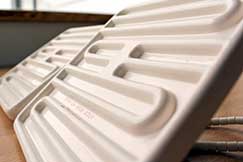InterTradeIreland will recognise the success of the FUSION project, completed in partnership with Findhan Strain and Belfast Metropolitan College, later this month. As part of this, Ceramicx recently hosted Clean Slate Television from Belfast. Michael Quinn and Gemma Major came down last Thursday and spoke with our MD, Frank Wilson and our FUSION Graduate, Peter Marshall about the project, its results and the wider FUSION project experience.

The FUSION programme is about innovation which is at the heart of everything that Ceramicx does. We’re constantly looking to evolve and drive efficiency in our heatwork products and help our customers optimise their heating applications. The FUSION project allowed us space, not just to develop a system for heating different types of carbon fibre, but deepen our understanding of this new material and apply the learnings from this across the company.
The experience with Clean Slate TV was really enjoyable with both sides provoking thought and learning about each others business. The video will be shown at the awards ceremony on Tuesday 23rd January 2018 in the Carton House Hotel, Maynooth.

Clean Slate Television is a Belfast based production company formed by David Kilpatrick and Michael Quinn, who each have over twenty years experience in television and radio production working for some of the worlds leading broadcasters including, BBC, RTE, Channel Four, National Geographic and Discovery.















